Krzysztof Rusek
Maximum entropy and quantized metric models for absolute category ratings
Oct 01, 2024
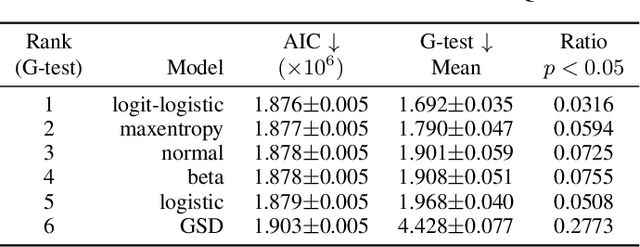
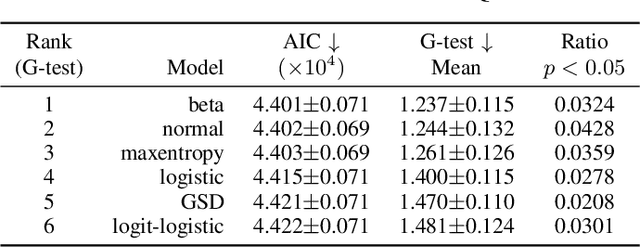
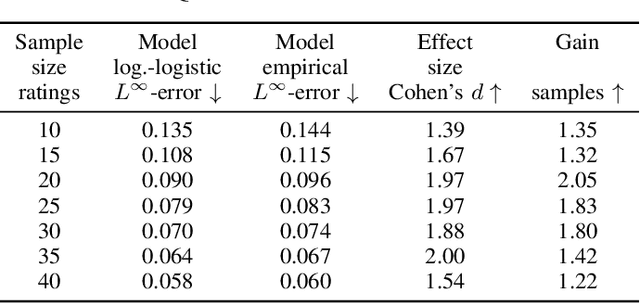
Abstract:The datasets of most image quality assessment studies contain ratings on a categorical scale with five levels, from bad (1) to excellent (5). For each stimulus, the number of ratings from 1 to 5 is summarized and given in the form of the mean opinion score. In this study, we investigate families of multinomial probability distributions parameterized by mean and variance that are used to fit the empirical rating distributions. To this end, we consider quantized metric models based on continuous distributions that model perceived stimulus quality on a latent scale. The probabilities for the rating categories are determined by quantizing the corresponding random variables using threshold values. Furthermore, we introduce a novel discrete maximum entropy distribution for a given mean and variance. We compare the performance of these models and the state of the art given by the generalized score distribution for two large data sets, KonIQ-10k and VQEG HDTV. Given an input distribution of ratings, our fitted two-parameter models predict unseen ratings better than the empirical distribution. In contrast to empirical ACR distributions and their discrete models, our continuous models can provide fine-grained estimates of quantiles of quality of experience that are relevant to service providers to satisfy a target fraction of the user population.
RouteNet-Fermi: Network Modeling with Graph Neural Networks
Dec 22, 2022



Abstract:Network models are an essential block of modern networks. For example, they are widely used in network planning and optimization. However, as networks increase in scale and complexity, some models present limitations, such as the assumption of markovian traffic in queuing theory models, or the high computational cost of network simulators. Recent advances in machine learning, such as Graph Neural Networks (GNN), are enabling a new generation of network models that are data-driven and can learn complex non-linear behaviors. In this paper, we present RouteNet-Fermi, a custom GNN model that shares the same goals as queuing theory, while being considerably more accurate in the presence of realistic traffic models. The proposed model predicts accurately the delay, jitter, and loss in networks. We have tested RouteNet-Fermi in networks of increasing size (up to 300 nodes), including samples with mixed traffic profiles -- e.g., with complex non-markovian models -- and arbitrary routing and queue scheduling configurations. Our experimental results show that RouteNet-Fermi achieves similar accuracy as computationally-expensive packet-level simulators and it is able to accurately scale to large networks. For example, the model produces delay estimates with a mean relative error of 6.24% when applied to a test dataset with 1,000 samples, including network topologies one order of magnitude larger than those seen during training.
RouteNet-Erlang: A Graph Neural Network for Network Performance Evaluation
Feb 28, 2022
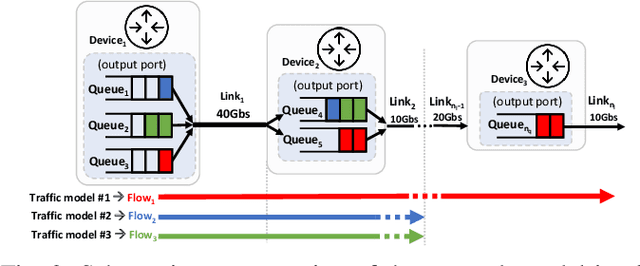
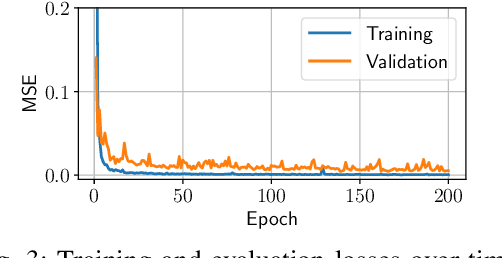
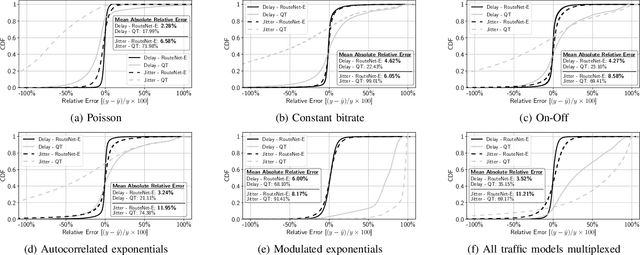
Abstract:Network modeling is a fundamental tool in network research, design, and operation. Arguably the most popular method for modeling is Queuing Theory (QT). Its main limitation is that it imposes strong assumptions on the packet arrival process, which typically do not hold in real networks. In the field of Deep Learning, Graph Neural Networks (GNN) have emerged as a new technique to build data-driven models that can learn complex and non-linear behavior. In this paper, we present \emph{RouteNet-Erlang}, a pioneering GNN architecture designed to model computer networks. RouteNet-Erlang supports complex traffic models, multi-queue scheduling policies, routing policies and can provide accurate estimates in networks not seen in the training phase. We benchmark RouteNet-Erlang against a state-of-the-art QT model, and our results show that it outperforms QT in all the network scenarios.
RiskNet: Neural Risk Assessment in Networks of Unreliable Resources
Jan 28, 2022Abstract:We propose a graph neural network (GNN)-based method to predict the distribution of penalties induced by outages in communication networks, where connections are protected by resources shared between working and backup paths. The GNN-based algorithm is trained only with random graphs generated with the Barab\'asi-Albert model. Even though, the obtained test results show that we can precisely model the penalties in a wide range of various existing topologies. GNNs eliminate the need to simulate complex outage scenarios for the network topologies under study. In practice, the whole design operation is limited by 4ms on modern hardware. This way, we can gain as much as over 12,000 times in the speed improvement.
Graph Neural Networks for Communication Networks: Context, Use Cases and Opportunities
Dec 29, 2021
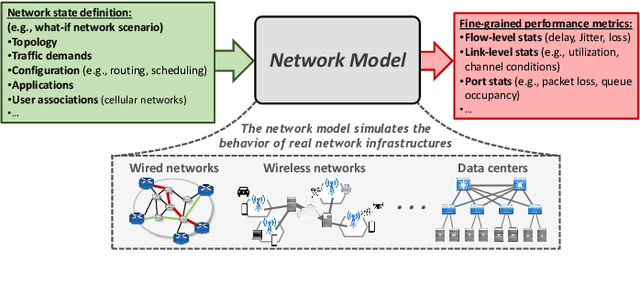
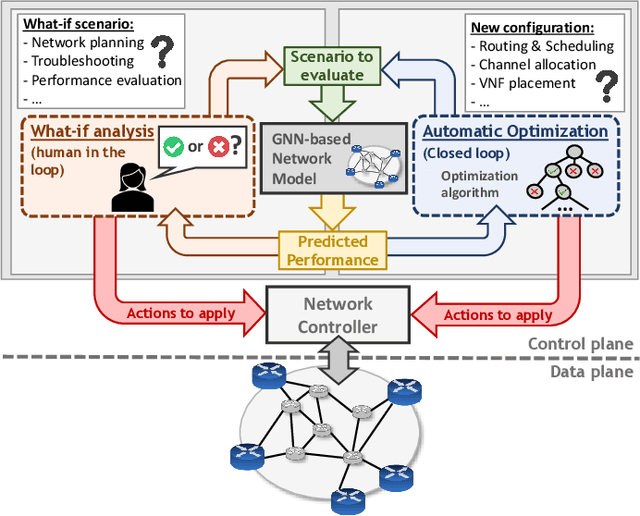
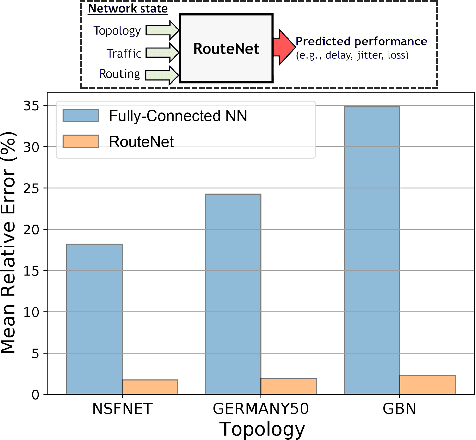
Abstract:Graph neural networks (GNN) have shown outstanding applications in many fields where data is fundamentally represented as graphs (e.g., chemistry, biology, recommendation systems). In this vein, communication networks comprise many fundamental components that are naturally represented in a graph-structured manner (e.g., topology, configurations, traffic flows). This position article presents GNNs as a fundamental tool for modeling, control and management of communication networks. GNNs represent a new generation of data-driven models that can accurately learn and reproduce the complex behaviors behind real networks. As a result, such models can be applied to a wide variety of networking use cases, such as planning, online optimization, or troubleshooting. The main advantage of GNNs over traditional neural networks lies in its unprecedented generalization capabilities when applied to other networks and configurations unseen during training, which is a critical feature for achieving practical data-driven solutions for networking. This article comprises a brief tutorial on GNNs and their possible applications to communication networks. To showcase the potential of this technology, we present two use cases with state-of-the-art GNN models respectively applied to wired and wireless networks. Lastly, we delve into the key open challenges and opportunities yet to be explored in this novel research area.
Scaling Graph-based Deep Learning models to larger networks
Oct 04, 2021
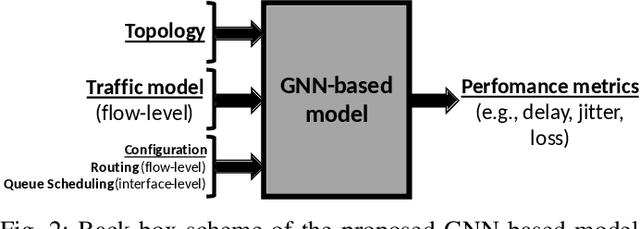
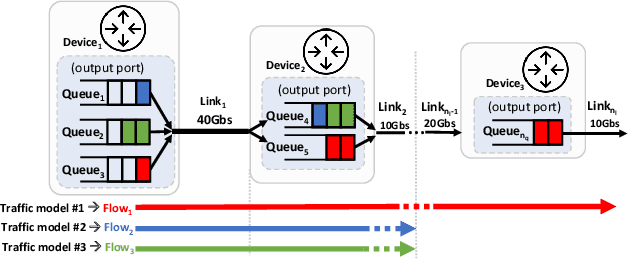
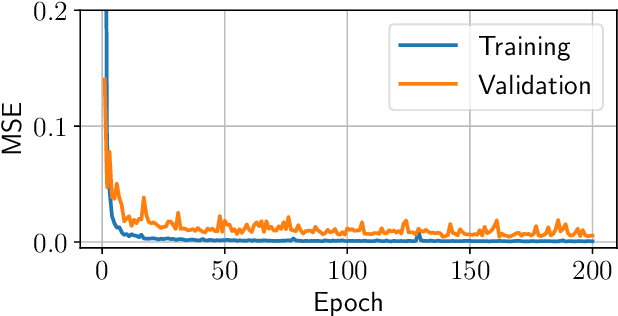
Abstract:Graph Neural Networks (GNN) have shown a strong potential to be integrated into commercial products for network control and management. Early works using GNN have demonstrated an unprecedented capability to learn from different network characteristics that are fundamentally represented as graphs, such as the topology, the routing configuration, or the traffic that flows along a series of nodes in the network. In contrast to previous solutions based on Machine Learning (ML), GNN enables to produce accurate predictions even in other networks unseen during the training phase. Nowadays, GNN is a hot topic in the Machine Learning field and, as such, we are witnessing great efforts to leverage its potential in many different fields (e.g., chemistry, physics, social networks). In this context, the Graph Neural Networking challenge 2021 brings a practical limitation of existing GNN-based solutions for networking: the lack of generalization to larger networks. This paper approaches the scalability problem by presenting a GNN-based solution that can effectively scale to larger networks including higher link capacities and aggregated traffic on links.
The Graph Neural Networking Challenge: A Worldwide Competition for Education in AI/ML for Networks
Jul 26, 2021

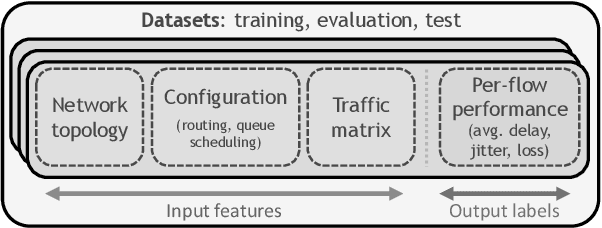
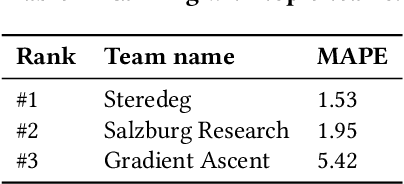
Abstract:During the last decade, Machine Learning (ML) has increasingly become a hot topic in the field of Computer Networks and is expected to be gradually adopted for a plethora of control, monitoring and management tasks in real-world deployments. This poses the need to count on new generations of students, researchers and practitioners with a solid background in ML applied to networks. During 2020, the International Telecommunication Union (ITU) has organized the "ITU AI/ML in 5G challenge'', an open global competition that has introduced to a broad audience some of the current main challenges in ML for networks. This large-scale initiative has gathered 23 different challenges proposed by network operators, equipment manufacturers and academia, and has attracted a total of 1300+ participants from 60+ countries. This paper narrates our experience organizing one of the proposed challenges: the "Graph Neural Networking Challenge 2020''. We describe the problem presented to participants, the tools and resources provided, some organization aspects and participation statistics, an outline of the top-3 awarded solutions, and a summary with some lessons learned during all this journey. As a result, this challenge leaves a curated set of educational resources openly available to anyone interested in the topic.
Deep Reinforcement Learning meets Graph Neural Networks: An optical network routing use case
Oct 16, 2019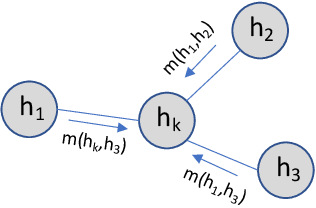
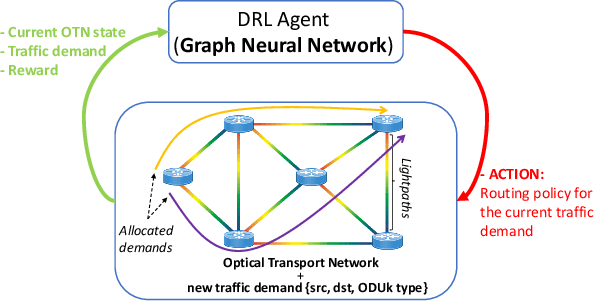
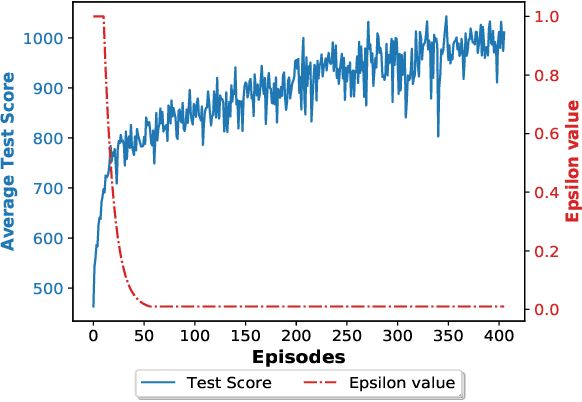
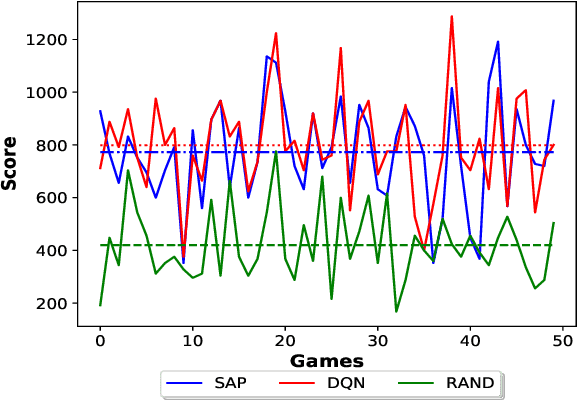
Abstract:Recent advances in Deep Reinforcement Learning (DRL) have shown a significant improvement in decision-making problems. The networking community has started to investigate how DRL can provide a new breed of solutions to relevant optimization problems, such as routing. However, most of the state-of-the-art DRL-based networking techniques fail to generalize, this means that they can only operate over network topologies seen during training, but not over new topologies. The reason behind this important limitation is that existing DRL networking solutions use standard neural networks (e.g., fully connected), which are unable to learn graph-structured information. In this paper we propose to use Graph Neural Networks (GNN) in combination with DRL. GNN have been recently proposed to model graphs, and our novel DRL+GNN architecture is able to learn, operate and generalize over arbitrary network topologies. To showcase its generalization capabilities, we evaluate it on an Optical Transport Network (OTN) scenario, where the agent needs to allocate traffic demands efficiently. Our results show that our DRL+GNN agent is able to achieve outstanding performance in topologies unseen during training.
RouteNet: Leveraging Graph Neural Networks for network modeling and optimization in SDN
Oct 03, 2019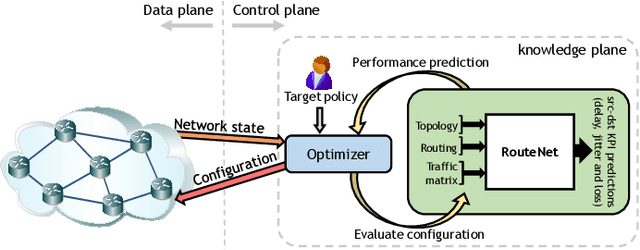
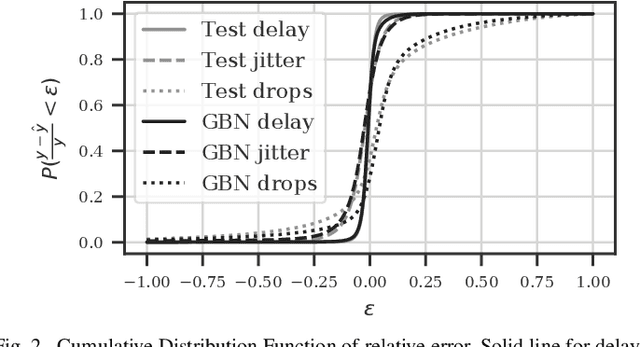


Abstract:Network modeling is a key enabler to achieve efficient network operation in future self-driving Software-Defined Networks. However, we still lack functional network models able to produce accurate predictions of Key Performance Indicators (KPI) such as delay, jitter or loss at limited cost. In this paper we propose RouteNet, a novel network model based on Graph Neural Network (GNN) that is able to understand the complex relationship between topology, routing and input traffic to produce accurate estimates of the per-source/destination per-packet delay distribution and loss. RouteNet leverages the ability of GNNs to learn and model graph-structured information and as a result, our model is able to generalize over arbitrary topologies, routing schemes and traffic intensity. In our evaluation, we show that RouteNet is able to predict accurately the delay distribution (mean delay and jitter) and loss even in topologies, routing and traffic unseen in the training (worst case $R^{2}$ = 0.878). Also, we present several use-cases where we leverage the KPI predictions of our GNN model to achieve efficient routing optimization and network planning.
 Add to Chrome
Add to Chrome Add to Firefox
Add to Firefox Add to Edge
Add to Edge